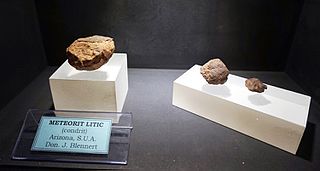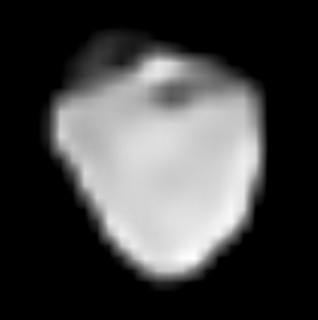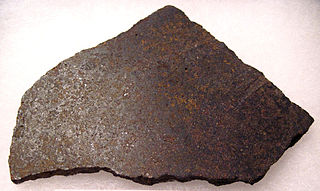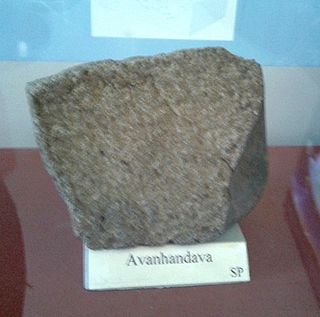Related Research Articles

In meteoritics, a meteorite classification system attempts to group similar meteorites and allows scientists to communicate with a standardized terminology when discussing them. Meteorites are classified according to a variety of characteristics, especially mineralogical, petrological, chemical, and isotopic properties.

A chondrule is a round grain found in a chondrite. Chondrules form as molten or partially molten droplets in space before being accreted to their parent asteroids. Because chondrites represent one of the oldest solid materials within the Solar System and are believed to be the building blocks of the planetary system, it follows that an understanding of the formation of chondrules is important to understand the initial development of the planetary system.

A chondrite is a stony (non-metallic) meteorite that has not been modified, by either melting or differentiation of the parent body. They are formed when various types of dust and small grains in the early Solar System accreted to form primitive asteroids. Some such bodies that are captured in the planet’s gravity well become the most common type of meteorite by arriving on a trajectory toward the Earth’s surface. Estimates for their contribution to the total meteorite population vary between 85.7% and 86.2%.

Hebe is a large main-belt asteroid, containing around 0.5% of the mass of the belt. However, due to its apparently high bulk density, Hebe does not rank among the top twenty asteroids by volume. This high bulk density suggests an extremely solid body that has not been impacted by collisions, which is not typical of asteroids of its size – they tend to be loosely-bound rubble piles.

The iron meteorites of the IIE chemical type are octahedrites of various coarseness, most of which contain numerous inclusions of recrystallized stony silicates.

The H type ordinary chondrites are the most common type of meteorite, accounting for approximately 40% of all those catalogued, 46% of the ordinary chondrites, and 44% of the chondrites. The ordinary chondrites are thought to have originated from three parent asteroids, whose fragments make up the H chondrite, L chondrite and LL chondrite groups respectively.

The ordinary chondrites are a class of stony chondritic meteorites. They are by far the most numerous group and comprise about 87% of all finds. Hence, they have been dubbed "ordinary". The ordinary chondrites are thought to have originated from three parent asteroids, with the fragments making up the H chondrite, L chondrite and LL chondrite groups respectively.

The L type ordinary chondrites are the second most common group of meteorites, accounting for approximately 35% of all those catalogued, and 40% of the ordinary chondrites. The ordinary chondrites are thought to have originated from three parent asteroids, with the fragments making up the H chondrite, L chondrite and LL chondrite groups respectively.

The LL chondrites are a group of stony meteorites, the least abundant group of the ordinary chondrites, accounting for about 10–11% of observed ordinary-chondrite falls and 8–9% of all meteorite falls. The ordinary chondrites are thought to have originated from three parent asteroids, with the fragments making up the H chondrite, L chondrite and LL chondrite groups respectively. The composition of the Chelyabinsk meteorite is that of a LL chondrite meteorite. The material makeup of Itokawa, the asteroid visited by the Hayabusa spacecraft which landed on it and brought particles back to Earth also proved to be type LL chondrite.

Aarhus is an H chondrite meteorite that fell to earth on 2 October 1951 at 18:15 in Aarhus, Denmark. The meteor split just before the otherwise undramatic impact and two pieces were recovered. They are known as Aarhus I and Aarhus II. Aarhus I was found in the small woodland of Riis Skov, just a few minutes after impact.
Andura is an H chondrite meteorite that fell to Earth on August 9, 1939, in Maharashtra, India.
Agen is an H chondrite meteorite that fell to earth on September 5, 1814, in Aquitaine, France.

Allegan is a type 5 H chondrite meteorite that landed in Michigan on July 10, 1899. Allegan weighed around fifty pounds after its landing. As of 1964, it was one of only seven known meteorites to land in Michigan.

Arroyo Aguiar is an H chondrite meteorite that fell to earth during the summer of 1950 in the province of Santa Fe, Argentina.
Assisi is an H chondrite meteorite that fell to earth at 7:00 am on May 24, 1886, in Perugia, Umbria, Italy.
Akbarpur is an H chondrite meteorite that fell to earth on April 18, 1838, in Uttar Pradesh, India. It is notable for being the first Indian meteorite for which an official report accompanied by a legal deposition was filed.

Avanhandava is an H chondrite meteorite that fell to earth in 1952 in São Paulo, Brazil.
Claxton is an L6 chondrite meteorite that fell to earth on December 10, 1984 in Georgia, United States. It is the only known meteorite to directly strike a mailbox.
This is a glossary of terms used in meteoritics, the science of meteorites.
CM chondrites are a group of chondritic meteorites which resemble their type specimen, the Mighei meteorite. The CM is the most commonly recovered group of the 'carbonaceous chondrite' class of meteorites, though all are rarer in collections than ordinary chondrites.